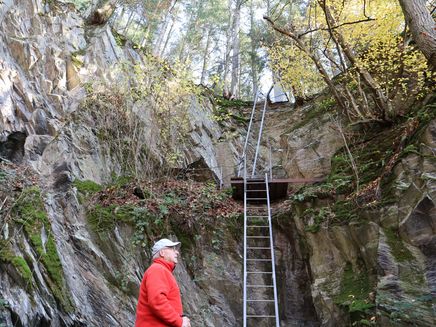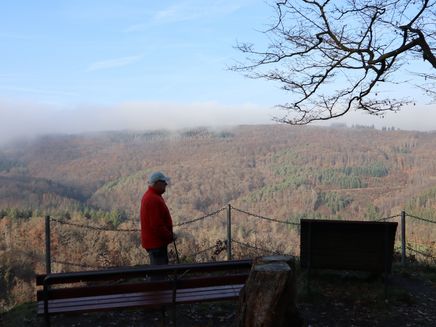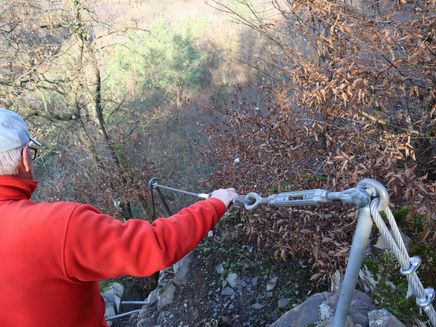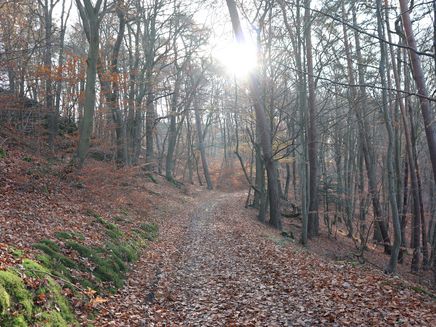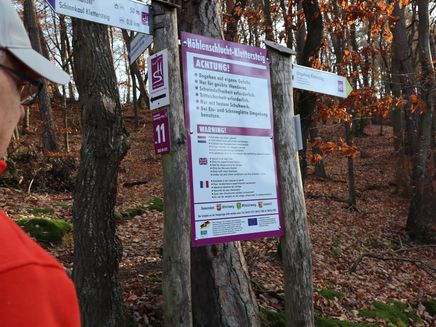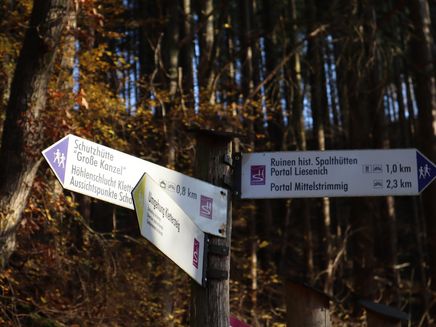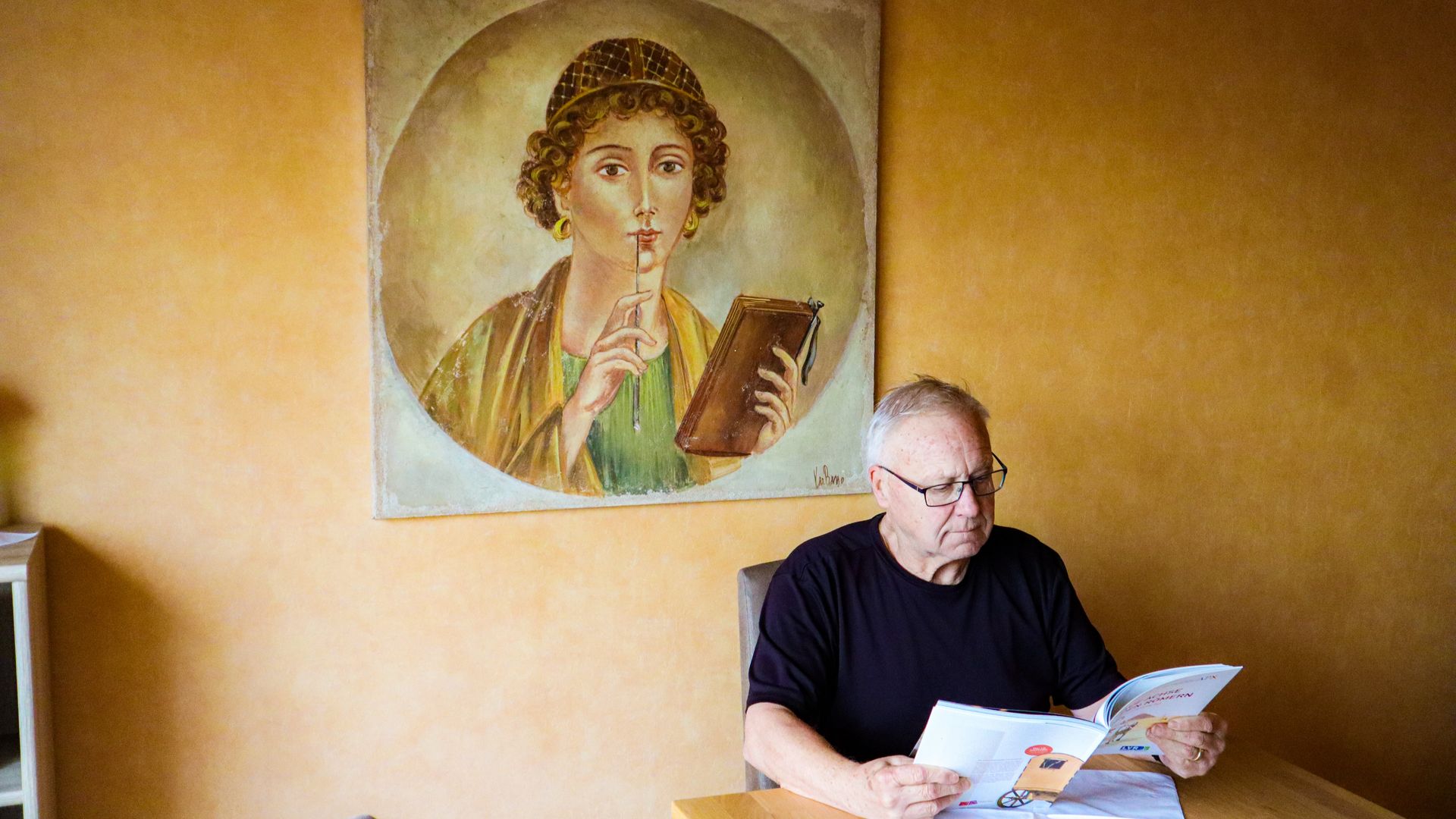It's another day in November when the fog has settled deep in the Mosel valley. But as I drive further and further up to Zell mountain and approach the Hunsrück heights, a wall suddenly opens up, and the fog disappears. I see bright blue skies and brilliant sunshine. I didn't expect this great weather this morning. Karl Rainer Manderscheid is already waiting for me, in hiking clothes, of course, because he wants to show me part of the "Layensteig Strimmiger Berg" dream loop today. We start at the village square in Mittelstrimmig with a short visit to the parish church. Karl Rainer is one of the initiators of the Layensteig. The entire trail is maintained by the local history and tourist associations of Altstrimmig, Mittelstrimmig and Liesenich.
As we march off in freezing temperatures, he tells me the story of how the dream loop came to be, and mainly in Mosel-Frankish, the dialect spoken here in the area, with the unique features of the Strimmiger Berg. "Do you smell that?" he interrupts himself. "Fresh country air, lovely." The passionate hiker knows almost every tree on the trail, pays attention to many details while walking. "That was important to us, with this trail," he says. „Mir wolde von Ofang oh on die Spetz". By "to the top", he means the award for premium trails with the German Hiking Seal. The trail was upgraded to 90 experience points by the "German Hiking Institute" during the last certification in October 2020. This puts it among the top 10 dream loops out of a total of 111 on the Saar-Hunsrück Climb. In 2010, the idea was born to participate in the emerging dream loops along the Saar-Hunsrück Climb with its route. So the three communities of Mittelstrimmig, Altstrimmig and Liesenich got together and looked for suitable ways.
It should already be something extra, with a lot of nature "I climbed around in the rocks for months looking for suitable paths and trails, which I did with great pleasure. If my wife had known where I was scrambling around..." he says with a smile. But the Hunsrückerjung (boy from the Hunsrück), born in Mittelstrimmig, knows the area well. The rocks were the best adventure playground for us as children. We stop at the Mittelstrimmiger cottage and the "Große Kanzel" (big pulpit) lookout point and enjoy the view of the light mist still visibly hanging in the Mosel valley and the sunshine bathing the autumnal trees in beautiful light. "We wanted to include different rocky outcrops and rock formations with great long views for the hiker," he says. As an inveterate hiker, he travelled everywhere, with a backpack and tent; he knows Mallorca from the past particularly well. Santiago de Compostella was also a hiking destination, but he is particularly fond of the Hunsrück-Rhine-Mosel region. He knows what is important for a good trail and has talked to many like-minded people beforehand. In 1991, he completed training as a certified tour guide. Since then, he has accompanied many guided hikes with guests and is on a first-name basis with everyone. "My greatest appreciation is when I sit with the guests at dinner in the evening, review the day and can say that the whole thing was fun. And that's how it has to be. My motto is: "A lot of walking makes you well-versed".
"So, off to new deeds and adventures," Karl Rainer ends the short stopover. Because we still have to go further. He wants to show me the new climbing route "Höhlenschlucht" on the route. Because every three years, the trail is inspected by the German Hiking Institute and new points are awarded. He chose the newly built path with the climbing path beforehand. Then it was built by many volunteers from all three communities in detailed work and with a lot of personal contribution. Everything was dug by hand. We climb over stiles between the moss-covered rocks and trees and come to his favourite spot: a bench with a view over the forest and to the church of Liesenich. "This is my favourite place; I call it the "Katharinenblick" because the church in Liesenich is dedicated to St. Katharina. This has been my favourite place for decades. The evening sunset and the call of the bell, which has been calling for evening prayer for centuries, are fascinating. "Just nature, just great," he beams as I bite into the bread I brought with me. And indeed the place is wonderful, so calming. He shows me the difference between spruces and firs, still remembers the Douglas firs that were planted here in the mid-1950s ("Ich wäs noch wie die gesatzt wure säi" / I still remember the planting). He remembers a rare juniper growing on a rock face from his childhood. He cuts it back every year. I realise that he didn't promise too much when he said at the beginning of our tour that he knows almost every tree on the Layensteig. And I notice his love for nature, for the forest and his homeland. No wonder the now 76-year-old is so fit! Immediately afterwards, we meet two hikers. Karl Rainer strikes up a conversation with them and asks them how they like the path. He is fully in his element.
Shortly afterwards, we come to the actual climbing path. Using a ten-metre ladder on a vertical rock face, we descend into an abandoned slate quarry and slate gallery. Generations of the roof and wall slate quarried here. At the end of the Second World War, the tunnels provided shelter for the population. He himself, he tells me, spent many of his first days of life in one of these tunnels. And I can see and imagine how much work it was. He tells me how they used to pour concrete here and how they used wheelbarrows to transport all the concrete down the mountain, and that over 100 metres of steel cables were used here. At the bottom, you can still see an old slate pit and a slate wall from that time. "Pure dramaturgy," says Karl Rainer. On our way back, I get to know Karl Rainer a bit more from his private side, his childhood in Mittelstrimmig, his former political interests, his many travels, and his second hobby: archaeology, another favourite subject besides hiking. As it turns out, he is a gifted connoisseur of the Celtic and Roman periods. Unforgettable is the discovery of a Roman coin hoard with about 25000 Roman coins, in which he was allowed to participate.
Two questions for Karl Rainer
1. what is so special about the Layensteig Strimmiger Berg dream loop?
"That many volunteers built the entire Dream loop. The three climbing routes, the active part of a dream loop, combined with quiet sections. Here you can "hear" the silence. It is not for nothing that the Layensteig is among the best 10 of 111 dream loops in the entire Saar Hunsrück region."
2. Karl Rainer, what is your favourite food?
"I really like home cooking in the typical Strimmiger Berg style, such as "Debbekooche" or "Kappes & Erwes" - sauerkraut with yellow peeled pea puree, rendered butter and smoked meat, served with sturdy bread."
